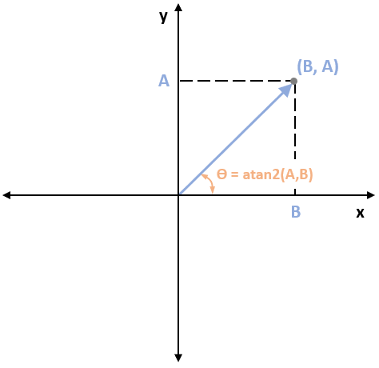atan2
Compute four-quadrant arctangent
Libraries:
Motor Control Blockset /
Controls /
Math Transforms
Motor Control Blockset HDL Support /
Controls /
Math Transforms
Description
The atan2 block performs the four-quadrant arctangent on two real numbers.
Equations
This equation describes how the block computes the four-quadrant arctangent
(θ).
where:
Ports
Input
Real number on the y-axis that you provide as input to the block.
Data Types: single | double | fixed point
Real number on the x-axis that you provide as input to the block.
Data Types: single | double | fixed point
Output
Angle represented by arctangent. This is the angle made by a vector from the origin to a specified point (x,y) with the positive x-axis.
Data Types: single | double | fixed point
The following figure shows the representation of input values A, B, and arctangent on the x-y coordinate plane.

Parameters
Type of approximation that the block uses for atan2 computation:
None— The block does not use any approximation.CORDIC— The block uses the approximation based on coordinate rotation digital computer (CORDIC) algorithm.Lookup— The block uses the lookup table based approximation.
Note
When you use the block for code generation:
Noneoption works better with single data type.CORDICoption works better for FPGA deployment.Lookupoption works better with fixed-point data type.
Unit of the output values.
Extended Capabilities
C/C++ Code Generation
Generate C and C++ code using Simulink® Coder™.
HDL Coder™ provides additional configuration options that affect HDL implementation and synthesized logic.
This block has one default HDL architecture.
| ConstrainedOutputPipeline | Number of registers to place at
the outputs by moving existing delays within your design. Distributed
pipelining does not redistribute these registers. The default is
|
| InputPipeline | Number of input pipeline stages
to insert in the generated code. Distributed pipelining and constrained
output pipelining can move these registers. The default is
|
| OutputPipeline | Number of output pipeline stages
to insert in the generated code. Distributed pipelining and constrained
output pipelining can move these registers. The default is
|
| SharingFactor | Number of functionally equivalent resources to map to a single shared resource. The default is 0. See also Resource Sharing (HDL Coder). |
If you run third-party (3p) simulation, the block may show a minor mismatch (of the
order 1e-7) in the simulation results because of an internal
trigonometric function that uses the floating point datatype.
Fixed-Point Conversion
Design and simulate fixed-point systems using Fixed-Point Designer™.
Version History
Introduced in R2020a
MATLAB Command
You clicked a link that corresponds to this MATLAB command:
Run the command by entering it in the MATLAB Command Window. Web browsers do not support MATLAB commands.
Sélectionner un site web
Choisissez un site web pour accéder au contenu traduit dans votre langue (lorsqu'il est disponible) et voir les événements et les offres locales. D’après votre position, nous vous recommandons de sélectionner la région suivante : .
Vous pouvez également sélectionner un site web dans la liste suivante :
Comment optimiser les performances du site
Pour optimiser les performances du site, sélectionnez la région Chine (en chinois ou en anglais). Les sites de MathWorks pour les autres pays ne sont pas optimisés pour les visites provenant de votre région.
Amériques
- América Latina (Español)
- Canada (English)
- United States (English)
Europe
- Belgium (English)
- Denmark (English)
- Deutschland (Deutsch)
- España (Español)
- Finland (English)
- France (Français)
- Ireland (English)
- Italia (Italiano)
- Luxembourg (English)
- Netherlands (English)
- Norway (English)
- Österreich (Deutsch)
- Portugal (English)
- Sweden (English)
- Switzerland
- United Kingdom (English)